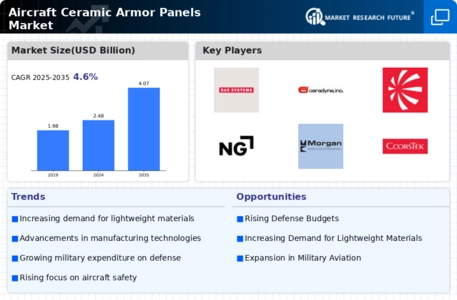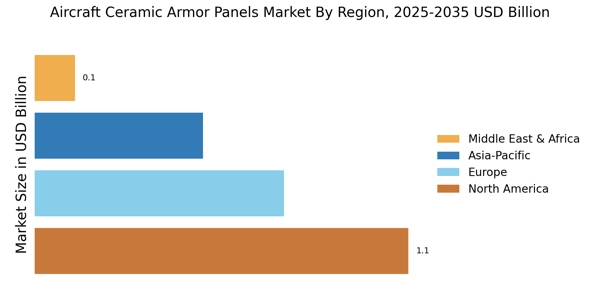Escalating Geopolitical Tensions
The Aircraft Ceramic Armor Panels Market is being propelled by escalating geopolitical tensions across various regions. As nations prioritize national security and defense capabilities, there is a marked increase in military spending, particularly in the procurement of advanced aircraft equipped with superior armor systems. This trend is evident in several countries that are modernizing their air forces to address emerging threats. The defense sector's focus on enhancing aircraft survivability is likely to drive demand for ceramic armor panels, which are known for their effectiveness against ballistic threats. Recent reports indicate that defense budgets are expected to rise by an average of 3% annually, further fueling the growth of the armor panels market.
Increased Focus on Aircraft Safety Standards
The Aircraft Ceramic Armor Panels Market is witnessing a heightened focus on safety standards within the aviation sector. Regulatory bodies are continuously updating safety protocols to ensure that aircraft meet rigorous protection requirements. This emphasis on safety is leading manufacturers to invest in advanced armor solutions, including ceramic panels, which provide superior protection against various threats. The implementation of stricter safety regulations is likely to drive the adoption of ceramic armor in both military and commercial aircraft. As a result, the market is expected to see a steady growth trajectory, with estimates suggesting an increase in demand by approximately 10% over the next few years.
Technological Innovations in Armor Materials
Technological advancements in materials science are significantly influencing the Aircraft Ceramic Armor Panels Market. Innovations such as the development of advanced ceramic composites and hybrid materials are enhancing the protective capabilities of armor panels. These innovations not only improve ballistic resistance but also contribute to weight reduction, which is crucial for aircraft performance. The introduction of nanotechnology in ceramic armor production is also noteworthy, as it enhances the durability and effectiveness of the panels. Market analysts suggest that the integration of these technologies could lead to a market expansion, with projections indicating a potential increase in market size by 15% over the next decade.
Rising Demand for Lightweight Armor Solutions
The Aircraft Ceramic Armor Panels Market is experiencing a notable increase in demand for lightweight armor solutions. This trend is primarily driven by the need for enhanced fuel efficiency and improved aircraft performance. As military and commercial aircraft manufacturers seek to reduce overall weight without compromising safety, ceramic armor panels have emerged as a preferred choice. The lightweight nature of these panels allows for better maneuverability and operational efficiency. According to recent data, the market for lightweight armor solutions is projected to grow at a compound annual growth rate of approximately 6.5% over the next five years. This growth indicates a robust shift towards advanced materials that meet the stringent requirements of modern aviation.
Growing Customization Needs in Defense Applications
The Aircraft Ceramic Armor Panels Market is increasingly influenced by the growing need for customization in defense applications. Military organizations are seeking tailored solutions that meet specific operational requirements, leading to a demand for bespoke armor systems. This trend is particularly evident in the development of aircraft that require unique armor configurations to address diverse threat environments. Manufacturers are responding by offering customizable ceramic armor panels that can be adapted to various aircraft designs and mission profiles. This shift towards customization is anticipated to enhance market competitiveness, with projections indicating a potential market growth of 12% as defense contractors seek innovative solutions to meet their unique needs.


















Leave a Comment